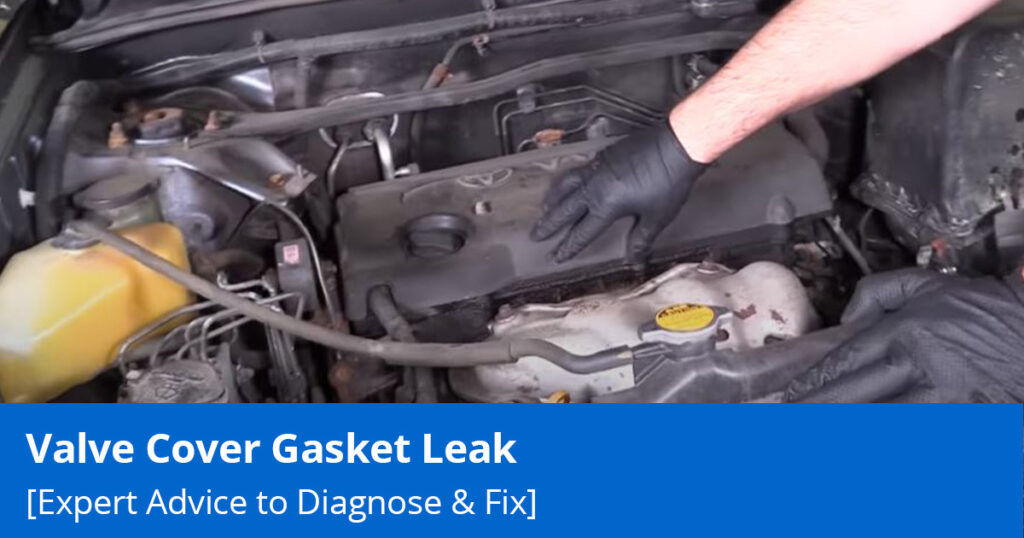
Learn to Diagnose and Fix That Burning Oil Smell
If you smell burning oil, your oil is low or your engine is running rough, you may have a valve cover gasket leak. In this video, our mechanic explains some typical valve cover gasket leak signs, and how to diagnose and fix them:
How to Diagnose Bad Leaking Valve Cover Gasket
What is a Valve Cover Gasket?
A valve cover gasket seals in motor oil to prevent any from leaking out of the valve train components. You’ll find it meets the top of the engine’s cylinder head.
Why is my valve cover gasket leaking?
When a valve cover gasket fails, you’ll typically find oily residue leaking out of it. The easiest way to know if your valve cover gasket is leaking is if there’s noticeable dirt or debris sticking to it. Since oil is sticky if any debris sticks to the gasket, that makes it clear there’s an oil leak.
Other signs of a valve cover gasket leak
If you check your oil regularly and keep finding that your engine oil is low, it could be leaking from your valve cover gasket.
The valve cover gasket also sometimes seals around where the spark plugs go into the engine, so you could find oil leaking down into the spark plug openings and around the spark plugs. That can cause your engine to run rough or misfire.
Valve cover gaskets are typically located near the exhaust manifold, which is hot when your engine is running. If oil leaks, it will burn off, and you’ll likely be able to smell it.
In some cases, you may even see smoke coming from underneath the hood.
If your valve cover gasket is leaking badly, it could cause a fire.
The PCV valve vents pressure from the engine back into the intake manifold and can become clogged and dirty over time. If it’s clogged, it can’t vent pressure, and the crankcase pressure will instead be pushed through the valve cover gasket, which can also cause a leak.

How to diagnose and fix a valve cover gasket leak
1. Inspect your valve cover gasket
If your car has a plastic cover over the valve cover(s) , remove it so you can inspect your valve cover & gasket.
Check out the oil fill cap to see if there’s any oil leaking from it.
Trace any oil to where it’s coming from. In our case, our mechanic found that the majority of the leaking oil came from a failed gasket. The oil was leaking from the seam between the valve cover and the cylinder head.
2. Replace the leaky valve cover gasket
If you have a four-cylinder overhead cam engine with a valve cover right on top, like the vehicle in the video, replacing the valve cover gasket is typically easy.
Replacing the valve cover gaskets in V6 or V8 engines can be a little more difficult because it may require needing to remove the intake. For a typical automotive DIYer, though, our mechanic says replacing a valve cover gasket is usually pretty simple.
3. Change your PCV valve if necessary
If your PCV valve seems to be what caused the leak or looks clogged, you should replace it according to your owner’s manual.
4. Removing and replacing the valve cover
If your ignition coils are located on top of the engine, like in our case, you’ll need to remove each coil pack.
The spark plugs are located underneath the coils, and those can be left alone—they don’t need to be removed.
Loosen the valve cover bolts, vacuum hoses, any electrical harnesses that are bolted to the valve cover gasket, and the PCV valve if you haven’t already.
Remove the valve cover and remove and replace the seal. It may be a little difficult to remove if the leaking oil has dried onto it.
Once the new seal has been replaced, replace the valve cover, and tighten all of the bolts.
Reinstall the coil packs and any hoses you removed.
5. Clean up any remaining oil
Use brake parts cleaner or engine degreaser to clean up any excess oil around the engine. Doing this is a good idea not only to remove any remaining spilled oil but also to help you identify any new leaks if your new valve cover gasket were to leak.
Find videos to help you replace your vehicle’s valve cover gasket, like this one in our video library:
How to Replace Valve Cover Gasket Set 01-05 Honda Civic
Need to replace a bad, leaky valve cover gasket, or other parts mentioned in this post? Shop now:
- Valve cover gaskets
- Engine and engine management parts
- Spark plugs
- Exhaust manifolds
- Intake manifolds
- PCV valves
- Ignition coils
- Valve covers
Related blog posts
Up next: Read these blog posts:
- Excessive Oil Consumption: Why It Happens, How to Prevent It, and How to Fix It
- How Often Should You Change Your Oil?
- How to diagnose a misfire: Expert help from our mechanics

